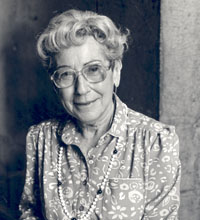Biographies
Mildred Cohn (b. 1913)

Mildred Cohn, born in 1913 in New York City, graduated high school at the age of 14. She received a bachelor’s of science degree in Chemistry from Hunter College in 1931, where the emphasis was firmly on training future chemistry teachers, not future chemists. Though discouraged by her professors at Hunter College from pursuing a graduate degree, Cohn entered the graduate program in Chemistry at Columbia University. Cohn was awarded a master’s degree in Chemistry in 1932, but had to leave the program because she was only able to afford one year of graduate school at that time. Cohn went to work for NACA, the predecessor to NASA, at Langley Field in Virginia for two years, saving up enough money to return to Columbia to finish her doctorate. In 1938 Cohn earned her Ph.D. in Physical Chemistry, and found a postdoctoral position in Vincent du Vigneaud’s laboratory at Washington University in St. Louis. Within a year du Vigneaud moved his laboratory to Cornell University Medical College in New York City, and Cohn moved with him. In 1946, when Cohn’s husband, physicist Henry Primakoff, received a faculty appointment at Washington University, Cohn was able to obtain a research position in Carl and Gerty Cori’s biochemistry laboratory in the University’s School of Medicine.
Cohn was promoted from research associate to research associate professor in 1958. For several years she was an established investigator for the American Heart Association. Cohn remained in St. Louis until 1960, when she and husband went to the University of Pennsylvania. Mildred Cohn joined the University’s Medical School faculty as an associate professor of Biophysics and Physical Biochemistry. She became a full professor the following year. Cohn retired as the Benjamin Rush Professor Emerita of Physiological Chemistry in 1982.
Mildred Cohn published over 160 scientific articles, covering research on isotopes, ATP (adenosine diphosphate and triphosphate), and oxidative phosphorylation. She worked in the laboratories of and co-authored scientific papers with six Nobel Laureates. Cohn was among the first to apply electron spin and nuclear magnetic resonance (NMR) to investigate metabolism.
Cohn was the first woman to be appointed to the board of the Journal of Biological Chemistry, where she served as editor for ten years (1958-63; 1968-73). A member of the National Academy of Science and recipient of the National Medal of Science, Cohn has been granted honorary doctorates from nine universities.
Return to WUMC Faculty/Staff (Biographies)
Return to All Biographies
Back to Top
